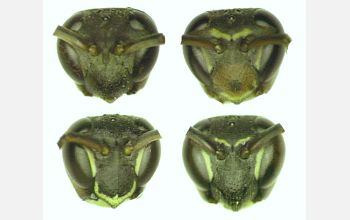Multimedia Gallery
Paper Wasp Faces
Portraits of four female paper wasps (Polistes fuscatus) collected from a single building in Ithaca, N.Y., by National Science Foundation-grantee Elizabeth Tibbetts, an animal behaviorist from Cornell University. The image illustrates the range of color patterns seen in the species. A wasp's color pattern is fixed for their entire adult life. Wasps learn the facial markings of their nestmates and then use these markings to identify their nestmates as individuals.
More about this Image
Researcher Elizabeth Tibbetts, a Cornell doctoral candidate in neurobiology and behavior, has found that the black and yellow coloring on the paper wasp is not uniform. One wasp can recognize another through facial and abdominal markings. This displaces the current theory that insects identify and communicate only through the use of chemicals called pheromones. Tibbetts has found that wasps can visually recognize individuals, including relatives and nestmates, through facial and abdominal markings, and will visually reject unfamiliar wasps.
To better understand the behavior of a wasp colony, she focused on the hierarchy of the nest. Queens and workers form a power structure that determines how food is distributed, how work tasks are assigned, and who will be allowed to lay eggs within the colony. Tibbetts concluded that a hierarchy such as this would be simplified if individuals of different ranks had some degree of individual recognition.
To test her theory that recognition is based on external markings rather than pheromones, she painted the faces and abdomens of a few test subjects, altering their yellow markings. When they returned to the nest, the painted wasps were not immediately recognized by the group and were the victims of considerable aggression. Fights broke out among former friends. However, paper wasps also identify themselves by giving off a scent from their exoskeleton and because of this, the nestmates were able to distinguish that the painted wasps were friends and not intruders. Tibbetts found that after a short period of time, the nestmates became familiar with the "new" painted markings and the altered wasps were no longer considered a threat, thus backing Tibbetts findings of individual recognition. Insects are generally thought to have poor vision so the use of visual cues by wasps was surprising to Tibbetts.
Tibbetts study, "Visual Signals of Individual Identity in Wasp Polistes fuscatus," appears in the Proceedings of the Royal Society of London B (Issue 269). Her study on wasp visual recognition, believed to be the first study of its kind, was supported by a graduate research fellowship grant from NSF. (Year of image: 2001)
Credit: Elizabeth A. Tibbetts
See other images like this on your iPhone or iPad download NSF Science Zone on the Apple App Store.
Images and other media in the National Science Foundation Multimedia Gallery are available for use in print and electronic material by NSF employees, members of the media, university staff, teachers and the general public. All media in the gallery are intended for personal, educational and nonprofit/non-commercial use only.
Images credited to the National Science Foundation, a federal agency, are in the public domain. The images were created by employees of the United States Government as part of their official duties or prepared by contractors as "works for hire" for NSF. You may freely use NSF-credited images and, at your discretion, credit NSF with a "Courtesy: National Science Foundation" notation.
Additional information about general usage can be found in Conditions.
Also Available:
Download the high-resolution TIFF version of the image. (859 KB)
Use your mouse to right-click (Mac users may need to Ctrl-click) the link above and choose the option that will save the file or target to your computer.

